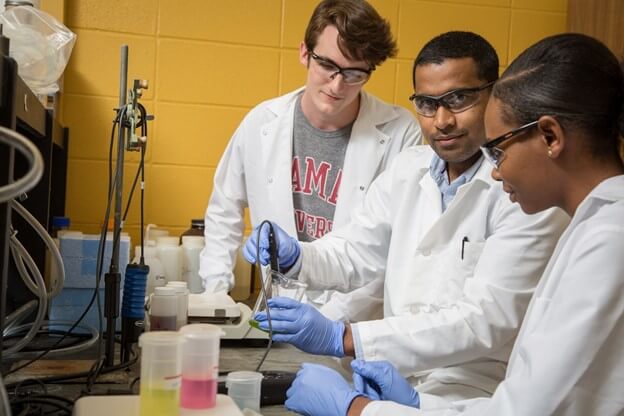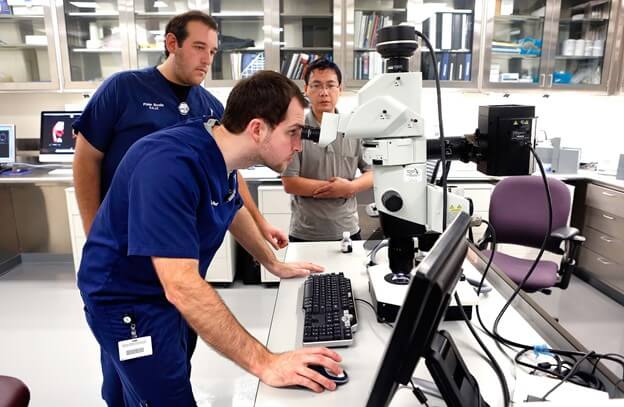
An engineering education in the US is a big investment. From time to savings and sacrifices, everything comes with a premium. Choose the right engineering school, however, and all of the above pays off.
According to the Bureau of Labour Statistics, engineers command the following median annual wages: US$108,540 (Chemical), US$88,570 (Civil), US$100,830 (Electrical), US$88,950 (Industrial), US$90,160 (Mechanical). But the return on investment is not just more money.
As an international student, you stand to meet peers, faculty members and staff from all over the world. There’s no better place to form meaningful connections and to bounce ideas to build the next big thing than at university.
Choose the right state and you could open doors to dynamic internships and other forms of valuable, experiential learning too. In Texas, for example, companies are building rockets for orbit, discovering the next biotech breakthrough and engineering a more secure cloud. Oregon has a 10-year Innovation Plan that aims to link students to innovative traded-sector companies by providing matching grants to offset costs of internship or co-ops.
Here are the US engineering schools with the best ROI:
Lamar University
If you seek a modern, affordable and top-ranked engineering education in one of the most economically important regions in the world, head to Lamar University in Beaumont, Texas. Here, you’ll follow curricula that meet industry needs, with focus areas in automation, sustainability and infrastructure, data science, and advanced manufacturing. You’ll fuse engineering theory with the software and management skills required by employers today.
In small classes, you’ll form meaningful relationships with faculty members and peers. On campus grounds, you’ll be part of a diverse community of 1,240 undergraduate students, 141 masters’ students and 71 doctoral students. Vibrant experiences — including internship opportunities — await beyond the college. In short, at Lamar University’s College of Engineering, you’re set to kickstart a journey — academically, professionally and personally — that will make a difference in society.
The College has five academic departments: Chemical Engineering, Civil and Environmental Engineering, Electrical Engineering, Industrial Engineering, and Mechanical Engineering. Bachelor’s, master’s and doctoral degrees are offered in each, plus a Master of Engineering Management degree.
Whichever programme your interests lie in, you will benefit from the distinctive Lamar combination of a location in the heart of industry, low tuition, small class sizes and research opportunities. The result? A high return on investment of your engineering education. Take the first steps to achieving your career dreams and aspirations — learn more about the College of Engineering here.
Oregon State University

Source: Oregon State University, College of Engineering
More than 40 world-class faculty members. US$8.5 million research expenditure. Almost 800 international graduate students comprising about 60% of the graduate programme. Ten areas of concentration including architectural engineering, construction engineering management, engineering education, geomatics, geotechnical engineering, infrastructure materials, coastal and ocean engineering, structural engineering, transportation engineering, and water resources engineering.
The Oregon State University College of Engineering is dedicated to addressing some of the world’s most complex engineering challenges — from climate change to economic instability. Here, students and faculty members combine curiosity, compassion, and intellect to create breakthroughs that help us live better lives.
“The teachers here inspire and motivate you to study. You use your problem-solving skills to solve real-life challenges,” shares Alisha Saduova, a PhD candidate from Kazakhstan focusing on pavement design and the mechanics of fluids.
Programmes and clubs such as Formula SAE and Engineers Without Borders make OSU students career-ready. Whereas high-impact research at the undergraduate and graduate levels — from safer bridge designs to next-generation robots — ensure OSU graduates have the skills and expertise that put them in a highly competitive position.
“We have one of the best programmes in the nation. We have luminary professors that give us all the things we need to train our thought process, to train how to do problem solving,” says Yunteng Huang, a PhD Electrical Engineering graduate.
Grand Valley State University

Source: Grand Valley State University
Hands-on. Practical. Industry-focused. 100% guarantee of experiential learning during studies. Nearly 100% employment upon graduation. 8,000 alumni with work experience in high-demand fields. These descriptors define an education at the Grand Valley State University (GVSU) Seymour and Esther Padnos College of Engineering & Computing (PCEC).
PCEC offers the following programmes in rapid-growth STEM fields: Computing & Information Systems (several undergraduate and graduate disciplines such as applied computer science, cybersecurity, and information technology), Engineering (several undergraduate and graduate disciplines such as biomedical engineering, computer engineering, and product design & manufacturing engineering); Occupational Safety & Health Management (undergraduate only) and Professional Science Master’s Programmes (several graduate disciplines such as applied statistics, data science & analytics, and health informatics & bioinformatics).
Each programme prepares students to become highly successful professionals in their field upon graduation. How? By beginning project-based learning in students’ first year. Students gain valuable work experience through industry internships or co-op placements, in which they collaborate with professionals to solve real industry problems and engage in applied research and development.
Internships or co-ops are required components of all PCEC programmes — all are paid, offset the cost of tuition (which is modest, and set at the same rate as domestic students at the graduate level), and often lead to job offers upon graduation.
To ensure international students’ success, the GVSU Padnos International Centre assists with a diverse range of issues, from finding a community on campus to obtaining OPT. As all PCEC programmes are STEM-designated, international students can qualify for up to three years of work experience in the US after graduation. Competitive and limited Graduate Assistantships arealso available to highly-qualified applicants.
Georgia Institute of Technology
Following a four-year curriculum, the School of Civil and Environmental Engineering’s Bachelor of Science in Civil Engineering arms graduates with the professional requirements needed to enter and excel in the workforce, or the solid groundwork to continue their studies.
This degree programme is designed with providing essential course materials in mind, offering students the flexibility to select elective courses with a wide topic coverage.
If you prefer to choose from a broad range of electives, the school is able to provide you with the options to meet your interests. This will enhance your ability to contribute to society in numerous ways, as well as your teamwork skills and adaptability to other disciplines.
Earlier this year, the 2021 list of engineering specialty programmes from the US News and World Report ranked both of the School of Civil and Environmental Engineering’s graduate programmes among the top five in the nation. The civil engineering graduate programme is ranked third and the environmental engineering program is fifth.
“It is extremely gratifying that our graduate programmes continue to be highly recognized nationally,” said Donald Webster, Karen and John Huff School Chair of the School of Civil and Environmental Engineering, “As always, we strive for excellence in addressing our mission to pursue cross-disciplinary research, service-based learning, and innovative course content and delivery.”









